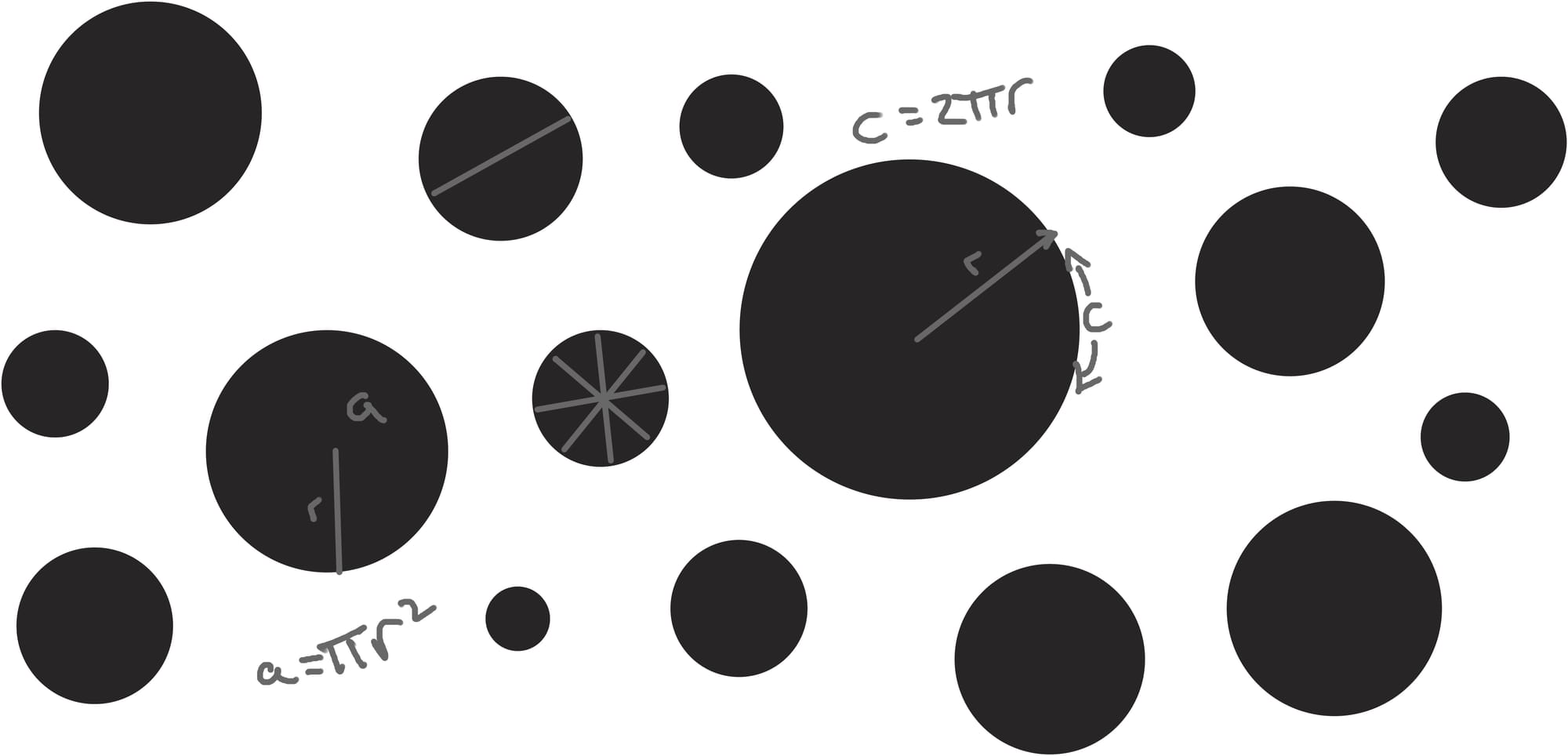An Etymology of Pie
Featuring shapes, colors, pastries, mathematicians, birds, and priests.

Today is March 14.
That may mean a different thing for different people, and each of those things is filled with color. Today is the Jewish holiday of Purim. In a way, it is a celebration of showing one’s true colors. Today is also the Indian holiday of Holi, the festival of colors, which is celebrated with brightly colored powders. Tomorrow begins the Ides of March, which, let’s just say, is very associated with the color “red”. On Monday, March 17, the locals of Chicago dye the Chicago River green in honor of the Irish holiday of St. Patrick’s Day. And its a week from Nowruz, which as we’ve seen, is a celebration of the color of Spring.
Circles
Today also has particular meaning for a demographic which contains people of all ethnic and religious backgrounds, and that is Pi day (US). Pi (π) is a mathematical constant first approximated to be 3.14 by the Greek mathematician Archimedes, who supposedly popularized the phrase “eureka”, after discovering that water displacement could determine an object’s volume.
Archimedes was a very relatable individual. For example, he was killed because a Roman soldier wanted to escort him to meet Marcus Claudius Marcellus after Syracuse was captured during the Second Punic War, and he declined the invitation because he was working on an equation. His purported last words to the Roman soldier were “do not disturb my circles”.
Using Pi (π), one could calculate a close estimation of the circumference of a circle by multiplying the diameter (or twice the radius 2πr) of the circle by 3.14. The area of a circle can be found by πr² or squaring the radius x 3.14. Pi (π) is a mathematical curiosity. The number is not precisely 3.14, obviously. It’s not even 3.141592. It’s likely an infinite sequence, with the first million digits of pi first discovered with the use of computers in 1973.
(Eating) Circular Pastry
In the English language, “pie” is also a circular pastry, which contains an outer shell and a filling. That meaning has extended to include pizza and the pizza pie, even though it is up for debate whether a pizza is functionally a pie, or a flatbread.
The US format for dates in month-day, so March 14 is 3.14, and celebrates math by eating pie. The rest of the world which writes dates in a day-month format apparently celebrates by eating pie on 22 July or 22/7, the lowest equivalent fraction to π.
Colorful As Pie
But this is a color newsletter, and as we have seen in the past, “pied” is a Middle English term for describe an object with two or more colors, usually black and white. Objects containing a larger array of brighter colors are would be described as “parti-colored”.
Unrelated, I would assume this is how the word “party” became associated with celebrations, and not simply a member representing a side of a contract or legal action.
Medieval Pie
To remind you, we saw the word “pied” quoted in William Shakespeare’s Love’s Labour’s Lost:
When Dasies pied, and Violets blew,
And Cuckow-buds of yellow hew:
And Ladie-smockes all silver white,
Do paint the Medowes with delight.
Love's Labour's Lost V,2
Similarly, if you’ve ever heard of the Pied Piper from Hamelin, the first word is describing the colors of his outfit.
Four and twenty blackbirds, Baked in a pye.
Most etymologists seem to connect the word “pie” to the chattering “magpie”, through the Old French, originating with the word pīca, the Latin term for magpie, as used by Pliny. Magpies are predominantly black and white birds, so it seems to make sense.
The Lewis-Short Latin Dictionary suggests that the word pīca was derived from pingo, meaning “to paint or to color”. Another word that is comes from pingo is pictor, meaning a painter.
As an aside, pingo as root for the black and white penguin makes a lot more sense than the word pinguis, which means “fat”. Or than the Oxford English Dictionary’s etymology as derived from the Welsh pen gwyn for “white head”.
Unrelated, I’m assuming the word pigeo, meaning "annoying" is the origin of the word “pigeon”.
Pissa Pie
Pico meant “to pitch, or tar”, and pix meant “tar or pitch”, ie, black. Pix is from the Greek πισσα (pissa) meaning “pitch”, as used by Homer. As painting would have been done with a black substance, it is easy to draw a line from a “pitch” to “painting” to “having two or more colors”, whether or not you include the black and white bird.
Obviously, according to the above cited Shakespeare quote, it evolved to mean any colors, not just black and white.
Fun Pied Priests Wordplay
For fun, what if pīca wasn’t how pied got its meaning.
We know that birds are often named after what they look like. Take the cardinal, the red bird named after its similarity to the vestments of the member of the Catholic Church with the same name.
Some of the earliest references in English to the word “pie”, “pied”, or some derivation thereof, were based on the black and white vestments of priests or monks. The word pious comes from the Latin pius or pie.
Therefore, the phrase “those pied priests” can be read in two different ways.
• Those black and white wearing priests
• Those pious priests
Nonbinary Language
I suspect that the wordplay was the point.
Language is fluid and fun. The binary or "either/or" approach of "was x the origin of y or not" isn't how people historically viewed the evolution of language. Humanity created myth, midrash, folk etymologies, and those "incorrect understandings" evolved to contain additional level of meaning for those words.
My ongoing research of tulips has led me to various medieval Italian dialects in which the word for plum is susina / susino. They knew the word susiano for Persian red tulips, and I suspect that plum trees appear to growing red tulips, which can be drawn in a very similar way. (This struck me as curious as I had noted that the word mistranslated as "thorns" in Song of Songs 2:2 may actually mean "plums".)
Whether that word had evolved from suceno from succinus, for the flowing or juicy (or even amber-colored) flesh of the plum, the visual pun caught on, and long after they stopped using susiano for tulips, they kept the word susina for plums, which confuses etymologists about the relation a fruit with a non-Persian origin would have to an ancient Elamite city. (Similarly, when describing a variety as "Damascene", does it mean that that variety is from Damascus, or that its color is scarlet red like damask?)
Metaphors
In any event, the evolution of language means that when we say that something is "easy as pie", it is not an observation about the ease of remembering pi to the 100th decimal point, or painting a masterpiece.
It's more like a "piece of cake".
